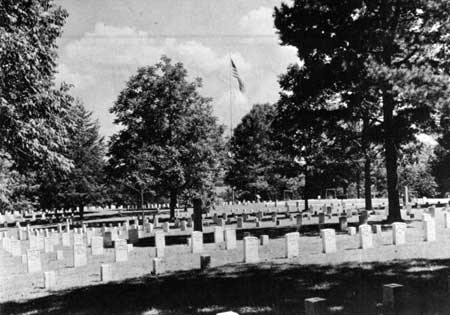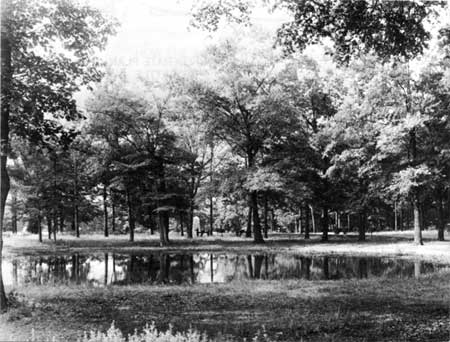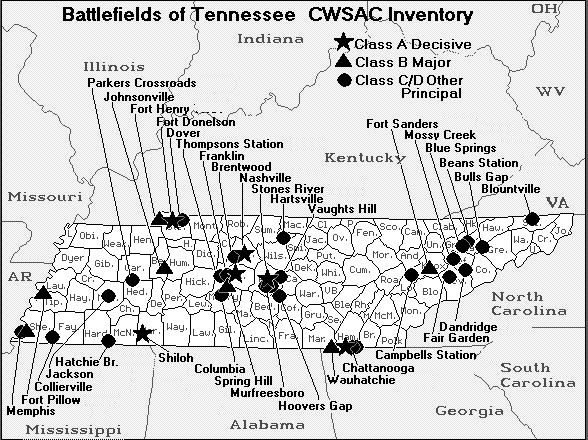|
Battle of Shiloh Casualties
| Shiloh National Cemetery |

|
| (Battle of Shiloh) |
Shiloh National Cemetery.
Results of the Battle
The losses on each side at Shiloh were unusually heavy. Grant's
army of 39,830 had been reinforced by 25,255 during the night between the 2 days' battle, swelling the total number of Union
troops engaged to 65,085, excluding a guard detachment of 1,727 men left at Crump's Landing. Of that total number 1,754 were
reported killed, 8,408 wounded, and 2,885 missing; presenting an aggregate of 13,047 casualties.
The army under Generals Johnston and Beauregard had gone into
battle with 43,968 men of all arms and condition. They received no reinforcements, except 731 men of Col. Munson R. Hill's
Tennessee Regiment who had reached the front unarmed and were furnished with arms and equipment picked up from the field.
The Southerners lost 1,728 killed, 8,012 wounded, and 959 captured or missing, or a total of 10,699 casualties.
"Present" and "Casualties" at Shiloh
|
|
Present
for duty |
Casualties
|
| Killed |
Wounded |
Missing |
Total |
|
| UNION |
|
| Army of the Tennessee (April 6) |
39,830 |
1,433 |
6,202 |
2,818 |
10,453 |
Reinforcements (April 7)
|
|
| Army of the Tennessee |
7,337 |
80 |
399 |
12 |
491 |
| Army of the Ohio |
17,918 |
241 |
1,807 |
55 |
2,103 |
|
|
| Total Federals engaged1 |
65,085 |
1,754 |
8,408 |
2,885 |
13,047 |
|
|
| CONFEDERATE |
|
| Army of the Mississippi (April 6) |
43,968 |
1,728 |
8,012 |
959 |
10,699 |
Reinforcements (April 7) |
|
| Hill's 47th Tennessee |
731 |
|
|
|
|
|
|
| Total Confederates engaged |
44,699 |
1,728 |
8,012 |
959 |
10,699 |
|
|
| GRAND TOTAL |
109,784 |
3,482 |
16,420 |
3,844 |
23,746 |
|
1 Does not include 1,727 troops left at Crump's Landing as rear guard.
| Bloody Pond. |

|
| (Battle of Shiloh) |
Bloody Pond.
During the first few weeks following the battle, both sides
claimed a victory. The Confederates based their claim upon the facts that they had inflicted an almost complete rout on the
Federals on Sunday, April 6, and that they had been able to hold a part of the field until they withdrew in good order on
Monday. Furthermore, they said, the Union armies were so battered that they were unable to pursue.
The Federals claimed the victory upon the grounds that on Monday
evening they had recovered their encampments and had possession of the field from which the Confederates had retired, leaving
behind a large number of their dead and wounded.
After the Battle of Shiloh the Confederates were compelled to
withdraw southward. Corinth was abandoned to the North on May 30th, severing the railroad from Memphis to Chattanooga. By
the end of June 1862, only those forts on the Mississippi River near Vicksburg remained in Southern hands. After a long siege,
Vicksburg fell to the North on July 4, 1863, cutting the Confederacy in two (fulfilling General Winfield Scott's Anaconda Plan).
| Battle of Shiloh Map |

|
| Civil War Battle of Shiloh Battlefield Map |
(Sources listed at bottom of page.)
Recommended
Reading: Shiloh--In Hell before Night. Description: James McDonough has written a good, readable and concise history of
a battle that the author characterizes as one of the most important of the Civil War, and writes an interesting history of
this decisive 1862 confrontation in the West. He blends first person and newspaper accounts to give the book a good balance
between the general's view and the soldier's view of the battle. Continued below…
Particularly
enlightening is his description of Confederate General Albert Sidney Johnston, the commander who was killed on the first day
of the battle. McDonough makes a pretty convincing argument that Johnston fell far short of the image that many give him
in contemporary and historical writings. He is usually portrayed as an experienced and decisive commander of men. This book
shows that Johnston was a man of modest war and command experience,
and that he rose to prominence shortly before the Civil War. His actions (or inaction) prior to the meeting at Shiloh -- offering
to let his subordinate Beauregard take command for example -- reveal a man who had difficulty managing the responsibility
fostered on him by his command. The author does a good job of presenting several other historical questions and problems like
Johnston's reputation vs. reality that really add a lot of
interest to the pages.
Recommended
Reading: Shiloh: The Battle
That Changed the Civil War (Simon & Schuster).
From Publishers Weekly: The bloodbath at Shiloh, Tenn.
(April 6-7, 1862), brought an end to any remaining innocence in the Civil War. The combined 23,000 casualties that the two
armies inflicted on each other in two days shocked North and South alike. Ulysses S. Grant kept his head and managed, with
reinforcements, to win a hard-fought victory. Continued below…
Confederate
general Albert Sidney Johnston was wounded and bled to death, leaving P.G.T. Beauregard to disengage and retreat with a dispirited
gray-clad army. Daniel (Soldiering in the Army of Tennessee) has crafted a superbly researched volume that will appeal to
both the beginning Civil War reader as well as those already familiar with the course of fighting in the wooded terrain bordering
the Tennessee River.
His impressive research includes the judicious use of contemporary newspapers and extensive collections of unpublished letters
and diaries. He offers a lengthy discussion of the overall strategic situation that preceded the battle, a survey of the generals
and their armies and, within the notes, sharp analyses of the many controversies that Shiloh
has spawned, including assessments of previous scholarship on the battle. This first new book on Shiloh
in a generation concludes with a cogent chapter on the consequences of those two fatal days of conflict.
Recommended
Reading:
Shiloh and the Western Campaign of 1862. Review: The bloody and decisive two-day battle of Shiloh (April
6-7, 1862) changed the entire course of the American Civil War. The stunning Northern victory thrust Union commander Ulysses
S. Grant into the national spotlight, claimed the life of Confederate commander Albert S. Johnston, and forever buried the
notion that the Civil War would be a short conflict. The conflagration at Shiloh had its roots in the strong Union advance
during the winter of 1861-1862 that resulted in the capture of Forts Henry and Donelson in Tennessee. Continued below…
The offensive
collapsed General Albert S. Johnston advanced line in Kentucky and forced him to withdraw all the way to northern Mississippi. Anxious to attack the enemy, Johnston began
concentrating Southern forces at Corinth, a major railroad center just below the Tennessee border. His bold plan called for his Army of the Mississippi to march north and destroy General Grant's Army of the Tennessee
before it could link up with another Union army on the way to join him. On the morning of April 6, Johnston
boasted to his subordinates, "Tonight we will water our horses in the Tennessee!"
They nearly did so. Johnston's sweeping attack hit the unsuspecting Federal camps at Pittsburg
Landing and routed the enemy from position after position as they fell back toward the Tennessee River.
Johnston's sudden death in the Peach Orchard, however, coupled
with stubborn Federal resistance, widespread confusion, and Grant's dogged determination to hold the field, saved the Union
army from destruction. The arrival of General Don C. Buell's reinforcements that night turned the tide of battle. The next
day, Grant seized the initiative and attacked the Confederates, driving them from the field. Shiloh
was one of the bloodiest battles of the entire war, with nearly 24,000 men killed, wounded, and missing. Edward Cunningham,
a young Ph.D. candidate studying under the legendary T. Harry Williams at Louisiana
State University, researched and wrote Shiloh and the Western Campaign of 1862 in 1966. Although it remained unpublished, many Shiloh
experts and park rangers consider it to be the best overall examination of the battle ever written. Indeed, Shiloh
historiography is just now catching up with Cunningham, who was decades ahead of modern scholarship. Western Civil War historians
Gary D. Joiner and Timothy B. Smith have resurrected Cunningham's beautifully written and deeply researched manuscript from
its undeserved obscurity. Fully edited and richly annotated with updated citations and observations, original maps, and a
complete order of battle and table of losses, Shiloh and the Western Campaign of 1862 will
be welcomed by everyone who enjoys battle history at its finest. Edward Cunningham, Ph.D., studied under T. Harry Williams
at Louisiana State
University. He was the author of The Port Hudson Campaign: 1862-1863
(LSU, 1963). Dr. Cunningham died in 1997. Gary D. Joiner, Ph.D. is the author of One Damn Blunder from Beginning to End: The
Red River Campaign of 1864, winner of the 2004 Albert Castel Award and the 2005 A. M. Pate, Jr., Award, and Through the Howling
Wilderness: The 1864 Red River Campaign and Union Failure in the West. He lives in Shreveport,
Louisiana. About the Author: Timothy B. Smith, Ph.D., is author of Champion Hill:
Decisive Battle for Vicksburg (winner of the 2004 Mississippi
Institute of Arts and Letters Non-fiction Award), The Untold Story of Shiloh: The Battle and the Battlefield, and This Great
Battlefield of Shiloh: History, Memory, and the Establishment of a Civil War National Military Park. A former ranger at Shiloh,
Tim teaches history at the University of Tennessee.
Recommended
Reading: Seeing the Elephant: RAW RECRUITS AT THE BATTLE OF SHILOH. Description: One of the bloodiest battles in the Civil War, the
two-day engagement near Shiloh, Tennessee,
in April 1862 left more than 23,000 casualties. Fighting alongside seasoned veterans were more than 160 newly recruited regiments
and other soldiers who had yet to encounter serious action. In the phrase of the time, these men came to Shiloh
to "see the elephant". Continued below…
Drawing on
the letters, diaries, and other reminiscences of these raw recruits on both sides of the conflict, "Seeing the Elephant" gives
a vivid and valuable primary account of the terrible struggle. From the wide range of voices included in this volume emerges
a nuanced picture of the psychology and motivations of the novice soldiers and the ways in which their attitudes toward the
war were affected by their experiences at Shiloh.
Recommended
Reading: Shiloh: A Novel, by Shelby Foote. Review: In the novel Shiloh, historian and Civil War expert Shelby
Foote delivers a spare, unflinching account of the battle of Shiloh, which was fought over
the course of two days in April 1862. By mirroring the troops' movements through the woods of Tennessee with the activity of each soldier's mind, Foote offers the reader a broad perspective
of the battle and a detailed view of the issues behind it. Continued below…
The battle
becomes tangible as Foote interweaves the observations of Union and Confederate officers, simple foot soldiers, brave men, and cowards and describes
the roar of the muskets and the haze of the gun smoke. The author's vivid storytelling creates a rich chronicle of a pivotal
battle in American history.
Recommended Reading: The Battle
of Shiloh and the Organizations Engaged (Hardcover). Description: How can an essential "cornerstone of Shiloh
historiography" remain unavailable to the general public for so long? That's what I kept thinking as I was reading this reprint
of the 1913 edition of David W. Reed's “The Battle of Shiloh and the Organizations Engaged.” Reed, a veteran of
the Battle of Shiloh and the first historian of the Shiloh National Military Park,
was tabbed to write the official history of the battle, and this book was the result. Reed wrote a short, concise history
of the fighting and included quite a bit of other valuable information in the pages that followed. The large and impressive
maps that accompanied the original text are here converted into digital format and included in a CD located within a flap
at the back of the book. Author and former Shiloh Park Ranger Timothy Smith is responsible for bringing this important reference
work back from obscurity. His introduction to the book also places it in the proper historical framework. Continued below…
Reed's history of the campaign and battle covers only seventeen pages and is meant to be a brief history of the subject.
The detail is revealed in the rest of the book. And what detail there is! Reed's order of battle for Shiloh goes down to the regimental
and battery level. He includes the names of the leaders of each organization where known, including whether or not these men
were killed, wounded, captured, or suffered some other fate. In a touch not often seen in modern studies, the author also
states the original regiment of brigade commanders. In another nice piece of detail following the order of battle, staff officers
for each brigade and higher organization are listed. The book's main point and where it truly shines is in the section entitled
"Detailed Movements of Organizations". Reed follows each unit in their movements during the battle. Reading this section along
with referring to the computerized maps gives one a solid foundation for future study of Shiloh.
Forty-five pages cover the brigades of all three armies present at Shiloh.
Wargamers and buffs will love the "Abstract of Field Returns". This section lists Present for Duty, engaged, and casualties
for each regiment and battery in an easy to read table format. Grant's entire Army of the Tennessee has Present for Duty strengths. Buell's Army of the Ohio is also counted well. The Confederate Army of the Mississippi
is counted less accurately, usually only going down to brigade level and many times relying only on engaged strengths. That
said, buy this book if you are looking for a good reference work for help with your order of battle.
In what I believe is an unprecedented move in Civil War literature, the University
of Tennessee Press made the somewhat unusual decision to include Reed's
detailed maps of the campaign and battle in a CD which is included in a plastic sleeve inside the back cover of the book.
The cost of reproducing the large maps and including them as foldouts or in a pocket in the book must have been prohibitive,
necessitating this interesting use of a CD. The maps were simple to view and came in a PDF format. All you'll need is Adobe
Acrobat Reader, a free program, to view these. It will be interesting to see if other publishers follow suit. Maps are an
integral part of military history, and this solution is far better than deciding to include poor maps or no maps at all. The
Read Me file that came with the CD relays the following information:
-----
The maps contained on this CD are scans of the original oversized maps printed in the 1913 edition of D. W. Reed's
The Battle of Shiloh and the Organizations Engaged. The original maps, which were in a very large format and folded out of
the pages of this edition, are of varying sizes, up to 23 inches by 25 inches. They were originally created in 1901 by the
Shiloh National Military Park under the direction of its historian,
David W. Reed. They are the most accurate Shiloh battle maps in existence.
The maps on the CD are saved as PDF (Portable Document Format) files and can be read on any operating system (Windows,
Macintosh, Linux) by utilizing Adobe Acrobat Reader. Visit http://www.adobe.com to download Acrobat Reader if you do not have
it installed on your system.
Map 1. The Field of Operations from Which the Armies Were Concentrated at Shiloh,
March and April 1862
Map 2. The Territory between Corinth, Miss., and Pittsburgh Landing, Tenn., Showing Positions and Route of the Confederate
Army in Its Advance to Shiloh, April 3, 4, 5, & 6, 1862
Map 3. Positions on the First Day, April 6, 1862
Map 4. Positions on the Second Day, April 7, 1862
Complete captions appear on the maps.
-----
Timothy Smith has done students of the Civil War an enormous favor by republishing this important early work on Shiloh. Relied on for generations by Park Rangers and other serious students of the battle, The Battle
of Shiloh and the Organizations Engaged has been resurrected for a new generation of Civil War readers. This classic reference
work is an essential book for those interested in the Battle of Shiloh. Civil War buffs, wargamers, and those interested in
tactical minutiae will also find Reed's work to be a very good buy. Highly recommended.
Source: Albert Dillahunty, Shiloh National Military Park Tennessee: National Park Service Historical Handbook
Series No. 10, Washington, D.C., 1955. Reprint 1961.
|

